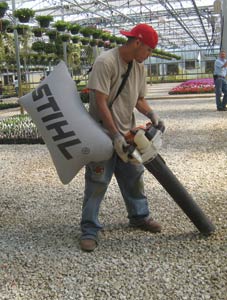6/15/2009
The Case for a Clean Greenhouse
P. Allen Hammer

The grower idea this month should remind everyone of the importance of a clean, organized greenhouse. Clean greenhouses do grow better plants with fewer insect and disease problems—a fact that has been stated over and over, yet it’s so very easy to forget in your struggles to turn a profit. Spending money on picking up and putting away is difficult to justify when the truck needs to be loaded.
I agree that it’s impossible to be neat and clean every single day; however, accepting sloppiness when we’re busy often slips into our everyday thinking. I also realize it’s much easier for me to walk into a greenhouse as a visitor and see the disorder than it is for those who work there each day. We often tend to accept and overlook the dirt because it simply becomes part of us.
How often have I seen someone walk over or around debris on the floor when it would be so easy to pick it up? Do you pick up debris as you walk around the greenhouse, or do you leave it for someone else to pick up? “It isn’t my job” can’t be in anyone’s thinking when it comes to cleanliness in the greenhouse. Cleanliness is everybody’s job.
I also strongly believe that a clean greenhouse improves the way everyone views the greenhouse. It improves employees’ attitudes and their work. Several gallons of paint (on the wall) may, in fact, be a great investment in your greenhouse. I’ll bet you get positive comments from your employees when you clean and update their work areas.
A great approach to dealing with cleanliness is to simply walk around the greenhouse with a digital camera and take photos. Then in the quiet of an evening, view the photos in a comfortable armchair. You’ll be amazed at what you notice in those photos. It provides a totally different view of what you see each day, and I’m sure it will lead to a new approach to cleaning and clutter in many greenhouses.
Problem plants
While not every plant is perfect, some greenhouses seem to have nothing but perfect plants. Most often, these greenhouses with seemingly perfect plants quickly rogue out the problem plants.
Some time ago, I suggested that sorting plants several times during production was an effective way of improving crop uniformity. With sorting, you can discard the problem plants. But even without sorting, you should discard problem plants often.
A similar issue is quickly discarding plants that are beyond their saleable window. Old, overgrown plants should be dumped or cut back because they’ll never become saleable by simply leaving them in the greenhouse in their overgrown state. Old plants can harbor insect and disease problems that will move to the growing crops. Plus, they’re simply depressing for everyone in the greenhouse to look at. I understand that discarding plants is shrink, and we want to do everything possible to reduce shrink. However, leaving non-saleable plants in the greenhouse doesn’t reduce shrink; it simply points it out over and over, every day.

Grower Idea of the Month
Jose Arteaga, Galema’s Greenhouse, West Lafayette, Indiana, uses a yard vacuum to remove plant debris from the gravel floor in the greenhouse. The vacuum has just enough suction to remove the leftover plant debris and root medium without sucking up the gravel. This particular model has a two-cycle engine, which requires good ventilation in the greenhouse to remove the engine exhaust. An electric model would probably be more suitable in most greenhouse situations; however, it’s easier to use the vacuum when it isn’t attached to an electrical cord. This is another example of a fairly simple solution to a significant greenhouse-cleaning problem. While this may not be the exact solution for your greenhouse, hopefully it creates some innovation in your thinking. I often find that someone else’s solution to a problem helps stimulate creativity.
P. Allen Hammer is a retired professor of floriculture at Purdue University, Lafayette, Indiana, and is now in product development and support for Dümmen USA.